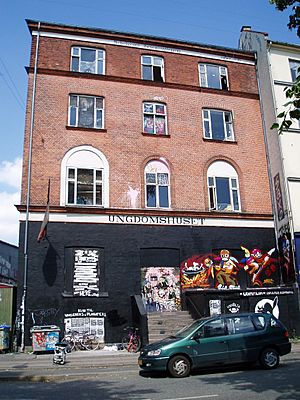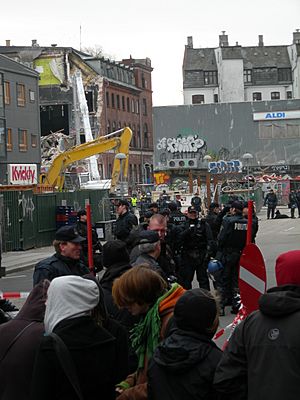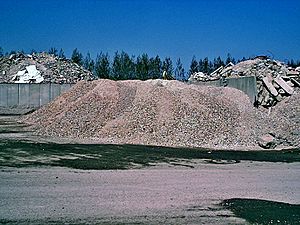Ungdomshuset facts for kids
Ungdomshuset (which means "the Youth House" in English) was a well-known building in Copenhagen, Denmark. Its official name was Folkets Hus ("House of the People"). Located at Jagtvej 69 in the Nørrebro area, it was a popular meeting place for many young people, especially those interested in underground music and certain political ideas.
From 1982 until 2007, Ungdomshuset was a hub for concerts, meetings, and various activities. However, there was a long disagreement between the people using the house and the city government of Copenhagen. This conflict ended on March 1, 2007, when police cleared the building. The demolition of Ungdomshuset started on March 5, 2007, and was finished two days later.
Since the building was torn down, former users and their supporters have held weekly demonstrations. They march to different places in Copenhagen, asking for a new Ungdomshuset. In the summer of 2007, a group called G13 tried to use an old public waterwork building as a new youth house. Police stopped them, arresting many people and using tear gas.
Contents
A Place for People: Its Early History
The building was finished on November 12, 1897. It was first called "Folkets Hus" (The People's House). In its early days, it was an important spot for the growing labour movement in Copenhagen. This movement worked to improve conditions for workers.
Over the years, the house also helped people in need. It was a place for many different activities. In 1910, a big meeting for women from around the world was held there. During this meeting, Clara Zetkin suggested the idea of an International Women's Day. Famous figures like Vladimir Lenin and Rosa Luxemburg also visited the center.
In the 1950s, the building was still mainly used by different worker groups and clubs. They held all sorts of events, from boxing matches to dances.
From Supermarket to Youth House
Later, a Danish supermarket chain called Brugsen bought Folkets Hus. They wanted to open a cheap supermarket there. But the authorities said no because the building was historically important. So, Brugsen sold the building to a folk music group called Tingluti in 1978.
After a short time, Tingluti sold the building to the municipality of Copenhagen. In 1982, the city gave Folkets Hus to a group of young people. These young people became the first users of what was then renamed Ungdomshuset. Many famous musicians, like Nick Cave and Björk, played concerts there.
In January 1996, a fire damaged Ungdomshuset. The building also had problems with fungus and rot. The city planned to fix it for safety reasons. However, the young people living there did not want the city to renovate.
In 1999, the city decided to sell the building. The young people living there were against this. As a joke, they put a large banner on the building. It said, "For sale along with 500 autonome, stone throwing, violent psychopaths from hell."
A company called Human A/S bought the building in December 2000. This company was later sold to a Christian group called "Faderhuset." But the young people refused to leave the house. They continued to use Ungdomshuset as if nothing had changed. The new owners were not allowed inside. Until March 1, 2007, Ungdomshuset welcomed more than 500 visitors every week.
The Demolition and Its Aftermath
The demolition of Ungdomshuset started at 8:00 AM on March 5, 2007. People could watch the demolition live on a webcam. After Ungdomshuset was torn down, there were many protests and riots in the area for several days. Cars were damaged and set on fire.
On March 8, a women's demonstration took place with over 3,000 people. Police checked the IDs of many people. In total, more than 750 people were arrested during these events. About 140 of them were from other countries.
On March 16, 2007, Danish police admitted they had accidentally used a dangerous type of tear gas. This gas, called Ferret 40, is meant to go through doors and walls. It was used against crowds during the protests, even though it could be very harmful.
Some experts, like Professor Lars Dencik, suggested that the Danish state might have used this event to test its anti-terrorist security forces.
Related Pages
- Autonomism
- Battle of Ryesgade
- Freetown Christiania
- Squatting
- Turbonegro (played their first show at Ungdomshuset in 1989)
Images for kids
See also
 In Spanish: Ungdomshuset para niños
In Spanish: Ungdomshuset para niños











